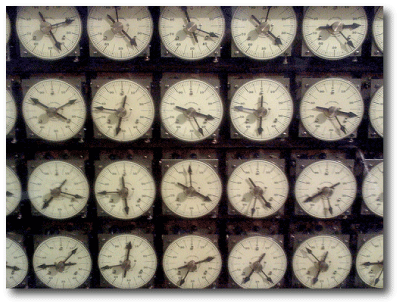
There have been a number of recent developments on the Alpha Centauri front.
Several weeks ago, Lee Billings wrote an article for Seed Magazine that delves at length into the hunt for terrestrial planets orbiting Alpha Cen. It hits a really inspiring tone. (I suggest pairing it with Nick Paumgarten’s equally well-written The Death of Kings to get a sense of how we’re living in what is effectively a bizarre superposition of worlds of varying habitability.) In keeping with the zeitgeist, the Alpha Cen story was also picked up last Monday with an article by Joel Achenbach in the Washington Post.
Billings’ article is entitled “The Long Shot”, with the reference being to Project Longshot, the far-out 1988 mission design for an unmanned 100-year nuclear pulse propelled mission to the Proxima/Alpha Centauri system. I, for one, definitely hope to be counted present when such a mission begins phase E.
Interestingly, the Seed article divulges an important clue to the extent of the Geneva Team’s current data set for Alpha Cen B, with the source apparently being a telephone interview with Michel Mayor:
Since 2003, Mayor and his team have used HARPS to search for planets around Alpha Centauri B. Last August, they began observing the star every available night in a strategy similar to Fischer’s.
The italics are mine, and for Alpha Cen fans, this is great news. Recent developments have made it abundantly clear that when HARPS is working full bore on a bright quiet star, it can drill right down into the habitable zone. If we assume that the statement in the above excerpt is accurate, we can put very interesting current limits on habitable planets in the Alpha Cen B system.
The star HD69830 (which harbors three-Neptune mass planets, see e.g. here and here) is a good proxy for Alpha Cen. The data set published in conjunction with the Lovis et al. article in Nature on HD 69830 contains 74 velocities taken over an 826 day period from Oct. 26 2003 through Jan 30 2006. That works out to 0.09 velocities per day, with each velocity having a reported instrumental error of ~0.8 m/s. This means that if Alpha Cen B received similar attention to that paid to HD 69830, then the Alpha Cen B data set as of last August would have contained ~160 velocities, each with ~0.8 m/s instrumental error.
If we look at the time series for HD 69830, however, we see that 160 Alpha Cen B velocities as of a year ago is likely an overestimate. It’s clear that the HD 69830 planets were starting to show after the first six months of observations, and as a result, the cadence on the star was increased by more than a factor of two. Based on the initial cadence on the star, it’s reasonable to expect that Alpha Cen B has been accumulating ~15 velocities per year, which works out to ~75 velocities in August 08 when the cadence was increased.
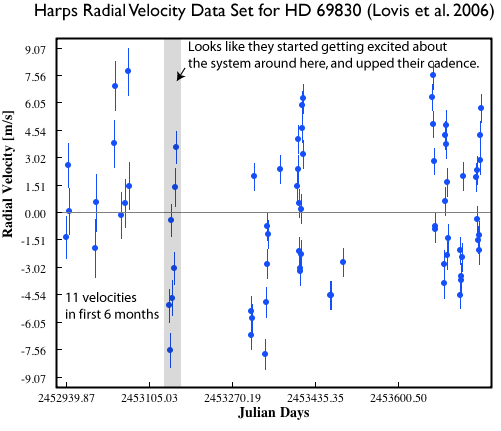
It seems reasonable to expect that when firing on all cylinders, HARPS can pull in 100 velocities per year for Alpha Cen B. This means that by the end of this summer, the Geneva team could quite reasonable be in possession of an N=175 point time series. Alpha Cen has near year-round observability from La Silla, so we can create a synthetic data sets which spread 75 velocities randomly across five years, followed by a year with 100 randomly spaced velocities. The data that the Geneva team currently have in hand probably look something like this:
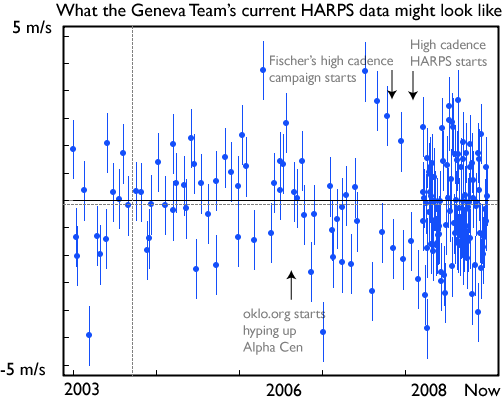
The habitable zone for Alpha Cen B is at P~250d. Let’s assume that a planet with this period has an orbit of eccentricity e~0.05, and look at representative Lomb-Scargle periodograms of Monte-Carlo data sets created for different values of the planet mass. In keeping with the results for Gliese 581 and HD 69830, let’s also assume a 1 m/s normally distributed radial velocity jitter produced by the star.
An Msin(i)=4.6 Earth-mass planet in an optimally habitable orbit around Alpha Cen B is worth USD 100K (which seems like a remarkably good deal). Three periodograms for different Monte-Carlo realizations indicate that such a planet would be right on the verge of current “announceability”:
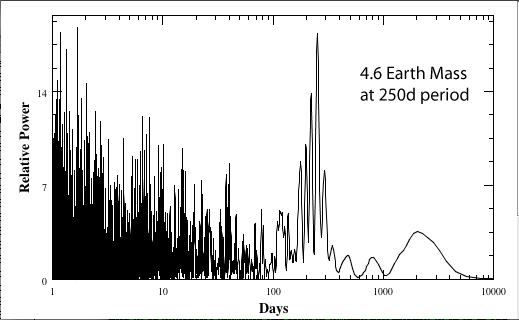
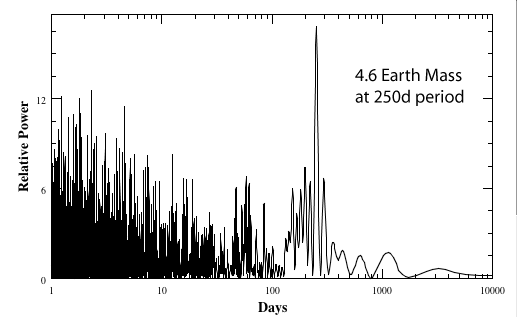
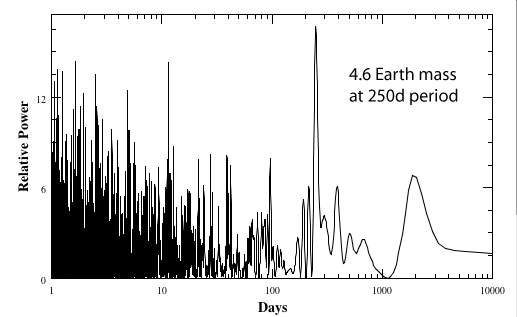
If the mass is reduced to Msin(i)=2.3 Earth masses (which jacks the value to a cool USD 227 million) the data sets (three of which are shown just below) are not quite seeing the planet yet. Another year and a half or so will be required.
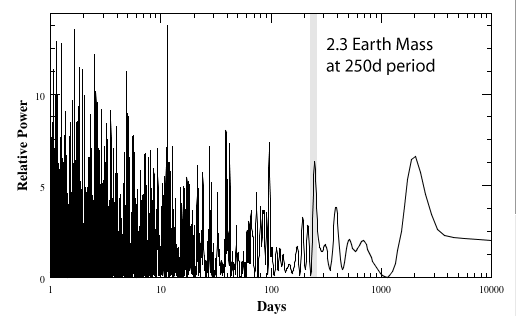
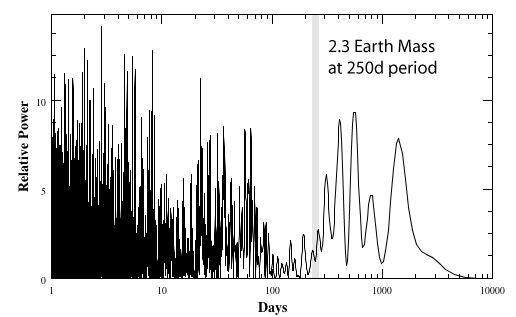
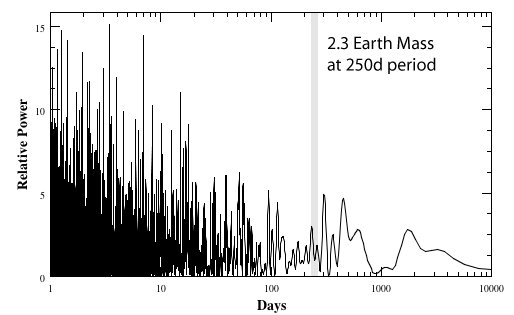
During the coming 18 months or so, we’ll therefore be in an interesting situation in which no news on Alpha Cen is very good news. Perhaps any Wall Street types who read this blog might try their hand at pricing an option on Alpha Cen Bb.
And finally, the theoretical objections to the formation of terrestrial planets orbiting Alpha Cen B are dissipating rapidly. I’ll pick up that story in an upcoming post…

http://archive.eso.org/eso/eso_archive_main.html
HAPRS
HD 128621
Number of Observations / Instrument
Total 8452
Cumulative Exposure Time / Instrument / Filter:
Total 17 h 32 min 18 s
period 2008-2009 years
-//-
2352 (28% total)
-//-
6 h 54 min 54 s (41% total)
What number RV-measurements in Debra Fisher?
Pingback: Alpha Centauri Hunt Intensifies